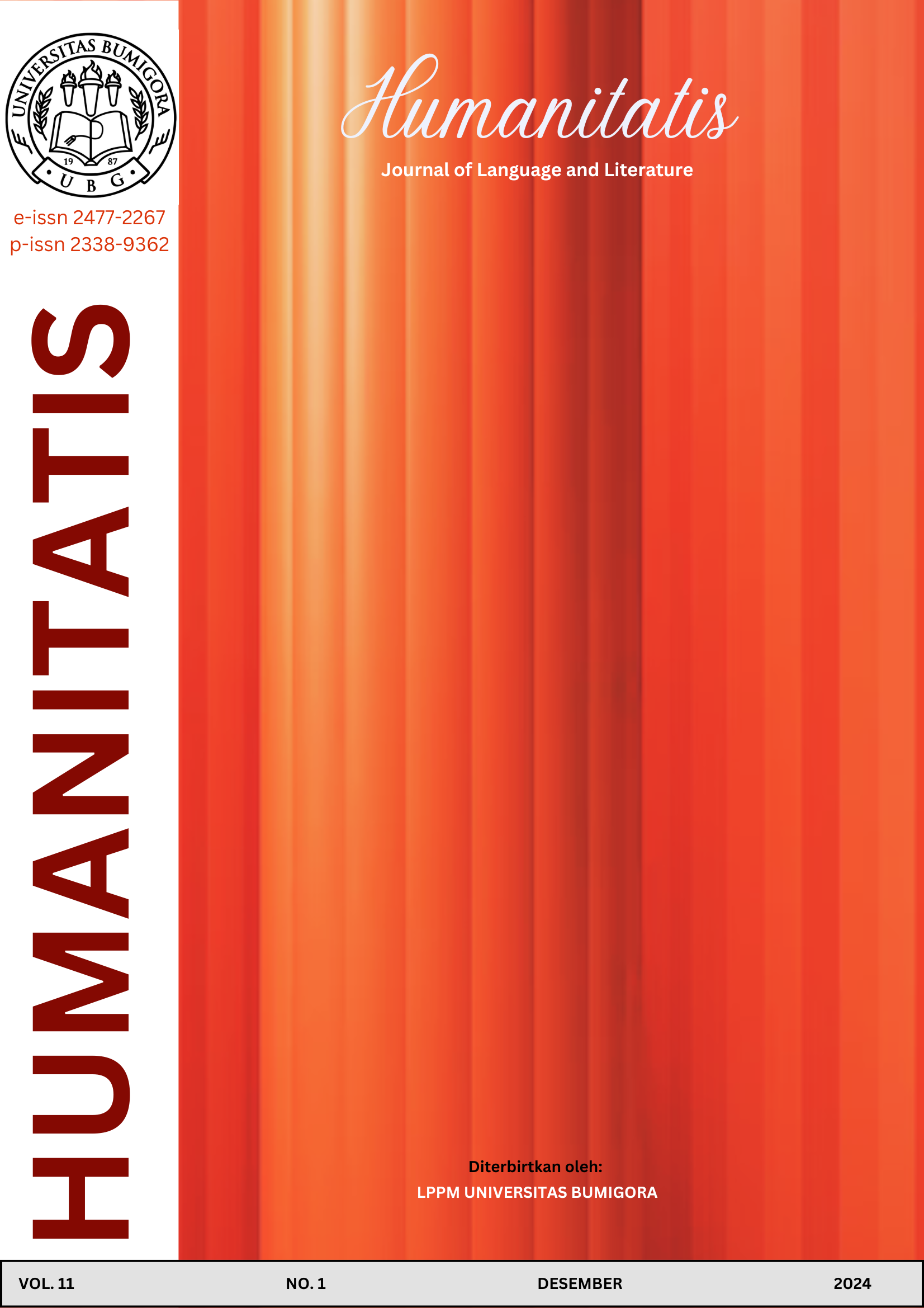Students’ Perception of Using Kahoot as an Online Assessment
DOI:
https://doi.org/10.30812/humanitatis.v11i1.4532Keywords:
Assessment, Education, Kahoot, Motivation, Perception, StudentsAbstract
Kahoot is an innovative assessment tool for education. This article examined students’ views on using Kahoot as a tool for teaching English in an online setting. This study employs a quantitative-descriptive approach. The study focused on a population of eighth-grade students enrolled in an English course consisting of 37 participants. This investigation utilized a Likert Scale and conducted interviews to gather data. The statements were categorized into five distinct forms: Strongly Agree (SA), Agree (A), Neutral (N), Disagree (D), and Strongly Disagree (SD). As indicated by their score of 1073, the majority of students were statistically neutral. Students perceive Kahoot as an enjoyable and user-friendly application with features that foster a constructive learning environment and promote healthy competition. This study’s findings indicate a positive development among students at SMPN 1 Lingsar utilizing Kahoot, highlighting engagement, motivation, competitiveness, and concentration. In summary, Kahoot offers an intuitive interface and appealing design that encourages student engagement in learning.
References
learning usıng kahoot! to enhance pre-universıty students’ active learning: A students’ perception in
biology classroom. Journal of Turkish Science Education, 18(1), 145–160. https://doi.org/10.36681/
tused.2021.57
Azlan, C. A., Wong, J. H. D., Tan, L. K., A.D. Huri, M. S. N., Ung, N. M., Pallath, V., Tan, C. P. L., Yeong,
C. H., & Ng, K. H. (2020). Teaching and learning of postgraduate medical physics using Internet-based
e-learning during the COVID-19 pandemic – A case study from Malaysia. Physica Medica, 80, 10–16.
https://doi.org/10.1016/j.ejmp.2020.10.002
Chiang, H.-H. (2020). Kahoot! In an EFL Reading Class. Journal of Language Teaching and Research, 11(1),
33–44. https://doi.org/10.17507/jltr.1101.05
Darma, V. P., Agus, C., & Rosalina, U. (2022). An Analysis Of Students’ Motivation In Teaching And Learning
Process By Using Kahoot. Journal of Social Science (JoSS), 1(1), 23–36. https://doi.org/10.57185/joss.
v1i1.5
DeJonckheere, M., & Vaughn, L. M. (2019). Semistructured interviewing in primary care research: A balance of
relationship and rigour. Family Medicine and Community Health, 7(2), 1–8. https://doi.org/10.1136/
fmch-2018-000057
Dermawan, R., Masito Mutiara, T., & Kurnisar, K. (2023). Penerapan Aplikasi Kahoot dalam Meningkatkan Hasil
Belajar Peserta Didik. Jurnal Penelitian dan Pendidikan IPS, 17(2), 163–171. https://doi.org/10.
21067/jppi.v17i2.8818
Dhingra, M., & Dhingra, V. (2011). Perception: Scriptures’ Perspective. Journal of Human Values, 17(1), 63–72.
https://doi.org/10.1177/097168581001700104
EkiNci-, M. (2020). Tümüyle Kahoot: ˙ Ingilizceyi Yabancı Dil Olarak Ögrenen Ö ˘ grenciler ˘ ˙ Için Rekabetçi Ögrenmeyi ˘
Te¸svik Etme. International Journal of Languages Education, 8.4(8.4), 305–318. https://doi.org/10.
29228/ijlet.46623
Elkhamisy, F. A. A., & Wassef, R. M. (2021). Innovating pathology learning via Kahoot! game-based tool: A
quantitative study of students‘ perceptions and academic performance. Alexandria Journal of Medicine,
57(1), 215–223. https://doi.org/10.1080/20905068.2021.1954413
Fathan, U. S. A., & Syafii, A. (2018). Kahoot as the Media Platform for Learn English. English Education:Journal
of English Teaching and Research, 3(1), 52–57. https://doi.org/10.29407/jetar.v3i1.11754
Fiani, I. N., Ahsanuddin, M., & Morhi, R. (2021). The Effectiveness of Using Kahoot! Application as An Evaluation
Tool in Arabic Vocabulary Learning at Madrasah Ibtidaiyah. Izdihar : Journal of Arabic Language
Teaching, Linguistics, and Literature, 4(2), 243–256. https://doi.org/10.22219/jiz.v4i2.17186
Ghazy, A., Wajdi, M., Sada, C., & Ikhsanudin, I. (2021). The use of game-based learning in English class. Journal
of Applied Studies in Language, 5(1), 67–78. https://doi.org/10.31940/jasl.v5i1.2400
Handoko, W., Mizkat, E., Nasution, A., Hambali, & Eska, J. (2021). Gamification in Learning using Quizizz
Application as Assessment Tools. Journal of Physics: Conference Series, 1783(1), 1–6. https://doi.
org/10.1088/1742-6596/1783/1/012111
Jeong, K.-O. (2023). Integrating Technology into Language Teaching Practice in the Post-COVID-19 Pandemic
Digital Age: From a Korean English as a Foreign Language Context. RELC Journal, 54(2), 394–409.
https://doi.org/10.1177/00336882231186431
Kurnia, M., Rahmawati, M., & Fitriyana, W. (2020). Playing e-quizzes with KAHOOT!: Students’ behavioral engagament on reading comprehension through KAHOOT! English Ideas: Journal of English Language
Education, 1(1), 29–39. Retrieved December 2, 2024, from https://journal.unsika.ac.id/IDEAS/article/
view/4177
Machaba, F., & Bedada, T. (2022). University lecturers’ preparedness to use technology in teacher training of
mathematics during COVID-19: The case of Ethiopia. South African Journal of Higher Education,
36(1), 171–192. https://doi.org/10.20853/36-1-4560
Mdlalose, N., Ramaila, S., & Ramnarain, U. (2021). Using Kahoot! As A Formative Assessment Tool in Science
Teacher Education. International Journal of Higher Education, 11(2), 43–51. https://doi.org/10.5430/
ijhe.v11n2p43
Miles, M. B., Huberman, A. M., & Saldaña, J. (2020). Qualitative data analysis: A methods sourcebook
(Fourth edition). SAGE.
Min, T. S., Rameli, M. R. M., Alhassora, N. S. A., & Abdullah, H. (2022). Effectiveness Of Using Kahoot!
Application In The Teaching Of Vocabulary On Perception And Achievement Of Low Achiever Students.
Journal of Positive School Psychology, 6(3), 2241–2251. https://journalppw.com/index.php/jpsp/
article/view/1937
Mohamed, A. M. (2024). Exploring the potential of an AI-based Chatbot (ChatGPT) in enhancing English as a
Foreign Language (EFL) teaching: Perceptions of EFL Faculty Members. Education and Information
Technologies, 29(3), 3195–3217. https://doi.org/10.1007/s10639-023-11917-z
Onojah, A. O., Onojah, A. A., Olumorin, C. O., & Abimbola, I. O. (2020). Study Technology: The Suitable Tenacity
to Learning Snags. JPI (Jurnal Pendidikan Indonesia), 9(3), 497. https://doi.org/10.23887/jpiundiksha.v9i3.25191
Özhan, ¸S. Ç., & Kocadere, S. A. (2020). The Effects of Flow, Emotional Engagement, and Motivation on Success
in a Gamified Online Learning Environment. Journal of Educational Computing Research, 57(8),
2006–2031. https://doi.org/10.1177/0735633118823159
Pérez, P., Gil, H., Artola, A., Royer, D. J., & Lane, K. L. (2023). Behavior-specific praise: Empowering teachers
and families to support students in varied learning contexts. Preventing School Failure: Alternative
Education for Children and Youth, 67(2), 83–90. https://doi.org/10.1080/1045988X.2023.2181303
Persson, P. B., Hillmeister, P., & Persson, A. B. (2022). Perception. Acta Physiologica, 235(3), e13842. https:
//doi.org/10.1111/apha.13842
Rahayu, R. P., & Wirza, Y. (2020). Teachers’ Perception of Online Learning during Pandemic Covid-19. Jurnal
Penelitian Pendidikan, 20(3), 392–406. https://doi.org/10.17509/jpp.v20i3.29226
Rahmadani, F. G., Saman, T. N., & Bahing. (2024). Students’ Perception of Game-Based Learning Using Kahoot!
In Learning English. EBONY: Journal of English Language Teaching, Linguistics, and Literature,
4(1), 28–38. https://doi.org/10.37304/ebony.v4i1.12442
Samboteng, L., Nadeak, B., Razati, G., Abidin, A. Z., & Rachman, R. S. (2023). The Effectiveness of Pre-test
and Post-test Using Kahoot in Increasing Students’ Attention. AL-ISHLAH: Jurnal Pendidikan, 15(1),
203–210. https://doi.org/10.35445/alishlah.v15i1.2833
Scott, N., & Liu, B. (2024, June 24). Sensation and Perception. In Tourism Social Science Series (pp. 59–72).
Emerald Publishing Limited. https://doi.org/10.1108/S1571-504320240000027006
Setiawan, J., Aman, A., & Wulandari, T. (2020). Understanding Indonesian history, interest in learning history
and national insight with nationalism attitude. International Journal of Evaluation and Research in
Education (IJERE), 9(2), 364–373. https://doi.org/10.11591/ijere.v9i2.20474
Sofyana, A. W., Faridi, A., & Shakiyya, Z. (2020). Implementation of Kahoot as a Digital Assessment Tool in
English Formative Test for Students of SMP Negeri 2 Temanggung in the Academic Year of 2019/2020.
English Education Journal, 10(4), 466–473. https://doi.org/10.15294/eej.v10i4.38619
Taghizadeh, M., & Hasani Yourdshahi, Z. (2020). Integrating technology into young learners’ classes: Language
teachers’ perceptions. Computer Assisted Language Learning, 33(8), 982–1006. https://doi.org/10.
1080/09588221.2019.1618876
Tao, H. (2022). Online English Teaching System Based on Internet of Things Technology (C. Venkatesan, Ed.).
Journal of Sensors, 2022, 1–8. https://doi.org/10.1155/2022/7748067
Yu, Z. (2021, September 1). A meta-analysis of the effect of Kahoot! on academic achievements and student
performance. https://doi.org/10.21203/rs.3.rs-842089/v1
Zheltukhina, M. R., Kislitsyna, N. N., Sergeeva, O. V., Knyazeva, S. A., Polovikov, I. P., & Tukhvatullina, L. R.
(2023). Trends of cultural studies in science education: A systematic review from 1973 to 2023. Eurasia
Journal of Mathematics, Science and Technology Education, 19(12), 1–9. https://doi.org/10.29333/
ejmste/13837












